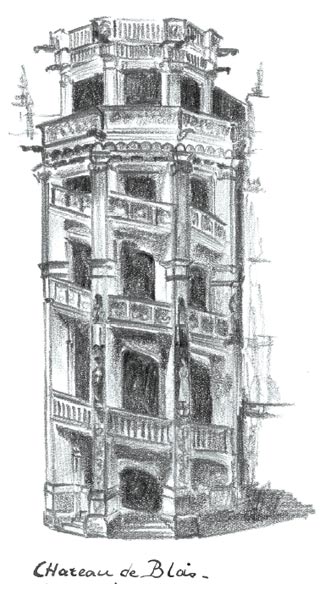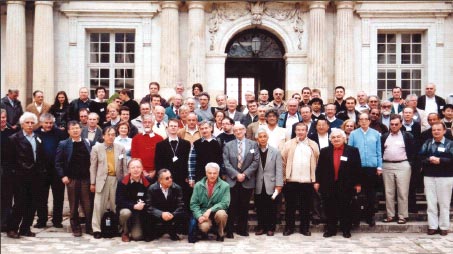Pomeron physics and QCD met once again at the XIth International Conference on Elastic and Diffractive Scattering: Towards High Energy Frontiers.
Twenty years ago the first “Blois Workshop” was organized by Basarab Nicolescu of the University Paris VI and Jean Tran Thanh Van of the University Paris Sud in the historic Château de Blois. Now, the 11th conference in this international biannual series focusing on elastic scattering and diffraction returned to Blois on 15-21 May 2005. Organized by the original team plus Maurice Haguenauer of the Ecole Polytechnique, it set the scene for future high-energy studies in this field.

Blois Workshops have taken place all over the world, and the meeting is now a scientific forum for researchers trying to unravel the foundations of elastic scattering and diffraction from first principles in quantum chromodynamics (QCD). Originally a rather specialized field, this has moved towards the centre of high-energy QCD studies. This is particularly because measurements at HERA and Fermilab show that diffractive events, where a scattered proton remains intact in a high-energy inelastic collision, constitute a surprisingly high proportion of the entire rate. Recent measurements from the ZEUS and H1 detectors at HERA show that approximately 10% of the deep inelastic lepton-proton scattering cross-section is diffractive.
High-energy elastic and diffractive scattering is traditionally explained in Regge theory as a result of pomeron exchange. Here the system exchanged between projectile and target carries the quantum numbers of the vacuum. Events with large gaps in the rapidity distribution occur even in hard collisions involving very high momentum transfers. Such “hard diffraction” has now become firmly established, initially at the Intersecting Storage Rings (ISR) and Super Proton Synchrotron (SPS) at CERN in proton and antiproton collisions, and now most clearly at HERA in positron-proton collisions, and in proton-proton collisions at the Relativistic Heavy Ion Collider (RHIC) at Brookhaven and the Tevatron at Fermilab.
With the advent of QCD, hard diffraction became attributed to the exchange of two or more gluons with net zero colour, and these processes are now an important observable for understanding fundamental aspects of the strong interactions. At the conference, Peter Landshoff from Cambridge and Sandy Donnachie from Manchester reviewed the apparent dichotomy between the soft and hard aspects of pomeron exchange and the phenomenological manifestations, such as the remarkable growth with energy of the cross-section for hard diffractive electroproduction of vector mesons. Theorists are beginning to develop formalisms that encompass the transition between hadron and quark-gluon degrees of freedom and the duality between the two descriptions.
QCD also predicts the existence of a C-odd three-gluon exchange, which through interference with the pomeron exchange leads to remarkable charge asymmetries in diffractive reactions.

One interesting nuclear diffractive phenomenon is the demonstration of QCD “colour transparency” by the E791 fixed-target experiment at Fermilab, which measured the diffractive dissociation of a high-energy 500 GeV/c pion into two high-transverse-momentum jets while leaving the target nucleus intact. The experiment confirmed the remarkable prediction, based on the gauge interactions of QCD, that the small quark-antiquark Fock component of the pion projectile interacts coherently on every nucleon in the nucleus without absorption or energy loss, in dramatic contrast with traditional Glauber theory. The diffractive dijet experiment also provides crucial information on the quark-antiquark wavefunction of the pion. Other diffractive experiments that explore the structure of the photon are now in progress at HERA.
Contrary to parton-model expectations, the rescattering of the quarks with the spectator constituents shortly after the nucleon has been struck by the lepton critically affects the final state in deep inelastic scattering (DIS). The rescattering of the struck quark from gluon exchange generates dominantly imaginary diffractive amplitudes. This gives rise to a dijet effective “hard pomeron” exchange – a rapidity gap between the target and the diffractive system – while leaving the target intact. The diffractive cross-section measured in diffractive deep inelastic scattering can be interpreted in terms of the quark and gluon constituents of an effective pomeron as in the model by Gunnar Ingelman and Peter Schlein. Since the gluon exchange occurs after the interaction of the lepton current, the pomeron cannot be considered a pre-existing constituent of the target proton. The rescattering contributions to the DIS structure functions are not included in the target proton’s wavefunctions computed in isolation, and cannot be interpreted as parton probabilities. The resulting gluon exchange matches closely the phenomenology of the soft colour interaction model. Gluon exchange in the final state also leads to Bjorken-scaling the Sivers single-spin asymmetry, a T-odd correlation between the spin of the target proton and the production plane of a produced hadron or quark jet.
The connections between diffraction and coherent effects in nuclei such as shadowing and anti-shadowing are also now being understood. Diffractive deep inelastic scattering on a nucleon leads to nuclear shadowing at leading twist as a result of the destructive interference of multistep processes within the nucleus. In addition, multistep processes involving Reggeon exchange lead to anti-shadowing. In fact, since Reggeon couplings are flavour-specific, anti-shadowing is predicted to be non-universal, depending on the type of current and even the polarization of the probes in nuclear DIS.
Saturation under focus
A central focus of the 2005 Blois conference was the physics of “saturation”, a QCD phenomenon that limits particle production when the underlying gluonic scattering subprocesses significantly overlap in space and time. At very high energies, the gluon density is so high that two scatterings have the same probability as one. The theory of saturation is based on the Balitsky-Kovchegov equation and its extensions, and has analogues with stochastic methods used in other areas of statistical physics. The effects of saturation can be observed in the small-x, high-energy domain of deep inelastic lepton scattering at HERA, thus providing a window into nonlinear aspects of QCD.
The theory of saturation predicts a parameterization of the HERA data (“geometrical scaling”) that gives a remarkably good description of the deep inelastic structure functions at small-x in terms of a single scaling variable. The high occupation number of gluons can even lead to the formation of a “colour glass condensate”, which may be causing a decrease of particle creation at forward rapidities in heavy-ion collisions at RHIC.
The nonlinear gluon interactions of QCD also underlie the physics of the hard Balitsky-Fadin-Lipatov-Kuraev pomeron, which is postulated to control the energy dependence of hard reactions, as well as the distribution of particle production at very small values of x and extreme values of rapidity.
Remarkably, Juan Maldacena’s “anti-de-Sitter-/conformal-field-theory (AdS/CFT) duality” between conformal gauge field theory and string theory in 10 dimensions has begun to make an impact on QCD studies. The mapping of quark and gluon physics onto the fifth dimension of anti-de Sitter space is providing insight into the gluonium spectrum that controls the pomeron trajectory and light-quark hadron spectroscopy. Moreover, it explains the success of QCD counting rules for hard elastic scattering reactions using the methods of Joseph Pochinsky and Matt Strassler.
The AdS/CFT correspondence also explains the dominance of the quark interchange mechanism in hard exclusive reactions, and gives a model for the basic light-front wavefunctions of hadrons that incorporates conformal scaling at short distance and colour confinement at large distances. Lattice gauge theory is also making an impact on the QCD physics of high-energy collisions.
Much of the phenomenological work in pomeron physics was pioneered by loyal participants in the Blois conference series. Many of the original participants of the first Blois Workshop attended the 20th anniversary conference and presented their current work. While the discussions at the first Blois Workshop centred on results from the ISR at CERN and the first data from the SPS as a proton-antiproton collider (with predictions for the Tevatron and Superconducting Super Collider projects), the XIth International Conference had speakers reporting the latest experimental results from the Tevatron, from polarized proton-proton (and proton-carbon) experiments using fixed and jet targets at RHIC, and from HERA at DESY. HERA II running has started and a significant and welcome statistical increase in diffraction data is expected before the machine closes down in 2007.
The experimental efforts under way regarding forward physics at the Large Hadron Collider (LHC) at CERN were extensively discussed; the large increase in reach in x and Q2 in proton-proton and nucleus-nucleus collisions will provide significant tests and advances for QCD-inspired diffraction phenomenology and calculations. There was also speculation that the Froissart bound for the total proton-proton cross-section will be saturated at the LHC, with its value controlled not by pion exchange but by the exchange of the lightest glueball, as originally predicted by Nicolescu. An exciting possibility for the future is observing the Higgs boson in doubly tagged diffractive collisions pp → p + H + p at the LHC; the Higgs would be found as a peak in the missing mass spectrum, rather than in a specific decay channel.
A number of presentations addressed existing and new cosmic-ray detector arrays, where the discrepancy above the Greisen-Zatsepin-Kuzmin cut-off between the excess in the Akena Giant Air Shower Array (AGASA) and the fall-off in the High Resolution Fly’s Eye (HiRes) experiment continues to generate interest. Some proposals for very forward instrumentation at the LHC are dedicated to providing benchmarks for simulations of cosmic-ray shower initiation: the Centauro and Strange Object Research (CASTOR) detector in TOTEM/CMS for forward electromagnetic showers, and in the proposed LHCf for the measurement of forward π0s. Zero-degree neutron calorimeters, which are operating successfully in the experiments at RHIC, will have counterparts in the heavy-ion programme at the LHC, but would also be very useful and complementary tools in the measurement of diffraction in proton-proton collisions.
The diffractive production of vector mesons and single hard photons at HERA provides a way to select and determine different generalized parton distributions (GPDs), the quantum-mechanical parton wavefunctions, of the proton. Early results from HERMES and from the H1 and ZEUS experiments seem to be in close agreement with current GPD models. A number of talks discussed the physics of other exclusive diffractive reactions such as two-photon collisions, which are sensitive to the vector meson distribution amplitudes as well as the exchange mechanism. Double-charm production, an indication of an intrinsic heavy-charm component in the proton wavefunction, was demonstrated by the SELEX experiment at Fermilab. The production of pentaquarks and other exotic quark bound states was reviewed with the conclusion that the situation is still very confused, with seemingly contradictory results.
At this anniversary, a number of overviews were presented surveying the progress in diffractive physics, both experimentally and theoretically, made over the past 20 years. Alan Krisch of Michigan told the story of his pioneering measurements of hadronic spin effects, and the extraordinarily large spin correlations that were discovered in large-angle elastic proton-proton scattering and that are still only partially understood. Konstantin Goulianos of Rockefeller University gave an overview of diffraction, both soft and hard, as measured at the Tevatron and its connection to results from HERA. Gunnar Ingelman of Uppsala presented the enormous evolution in understanding of hard diffraction since it was first observed by UA8 at CERN’s proton-antiproton collider.
The overall atmosphere of the conference was one of expectation: for the data from the new runs that have started at the Tevatron and at HERA II, and from the LHC which will start running around the time of the next Blois conference. Indeed, the next two meetings may well see significant progress in the understanding of both soft and hard diffraction.





